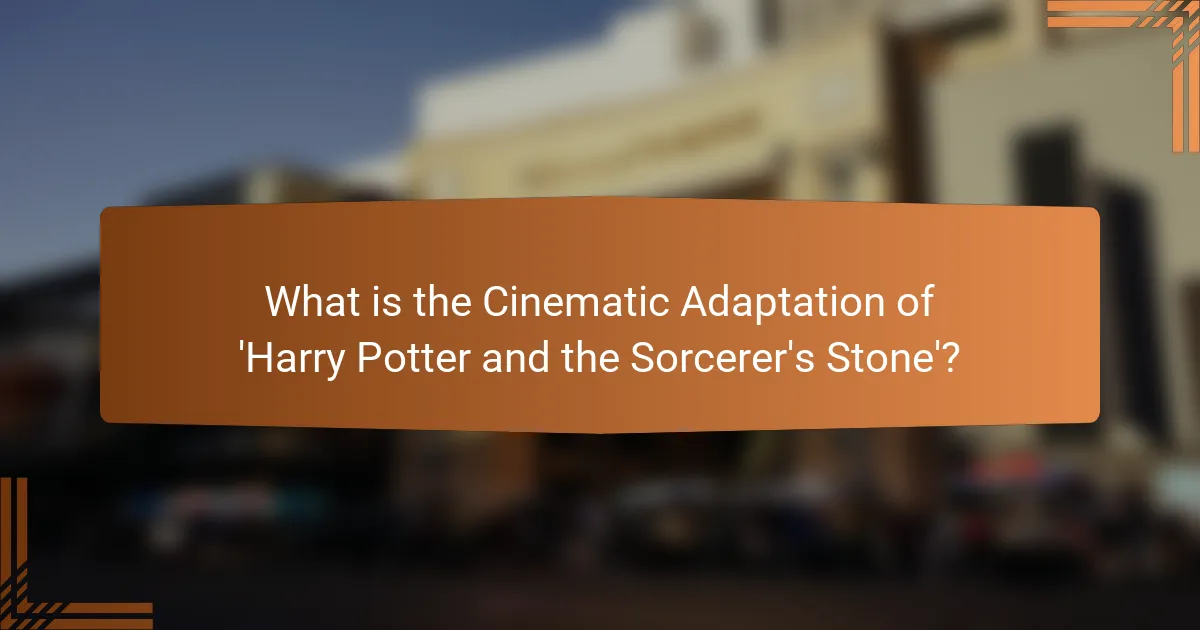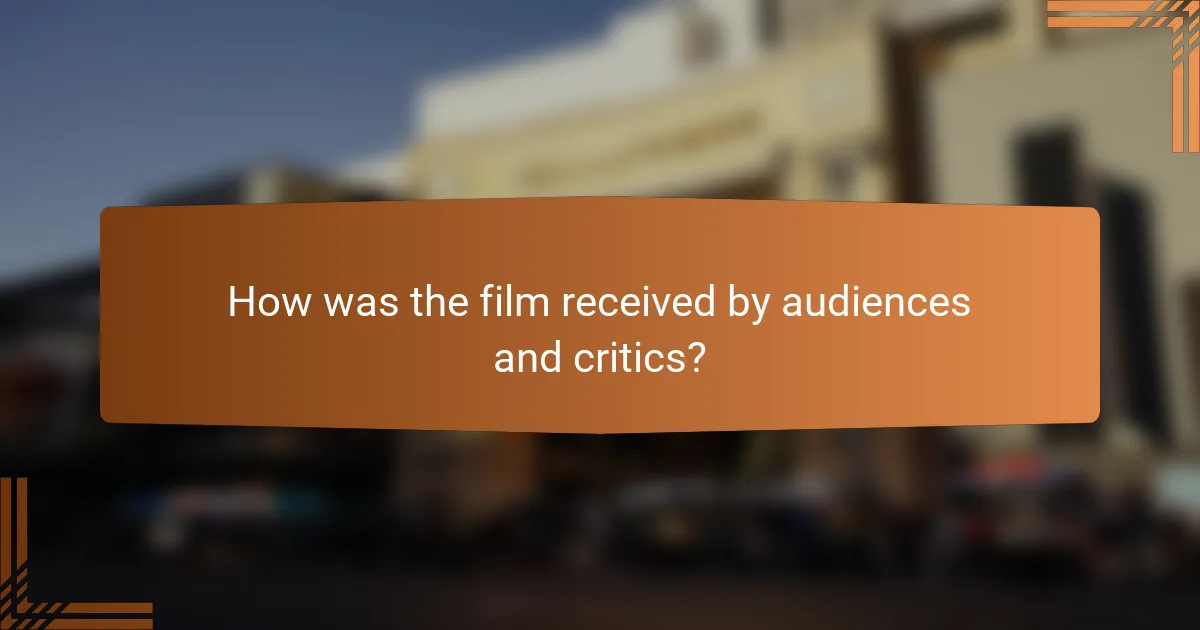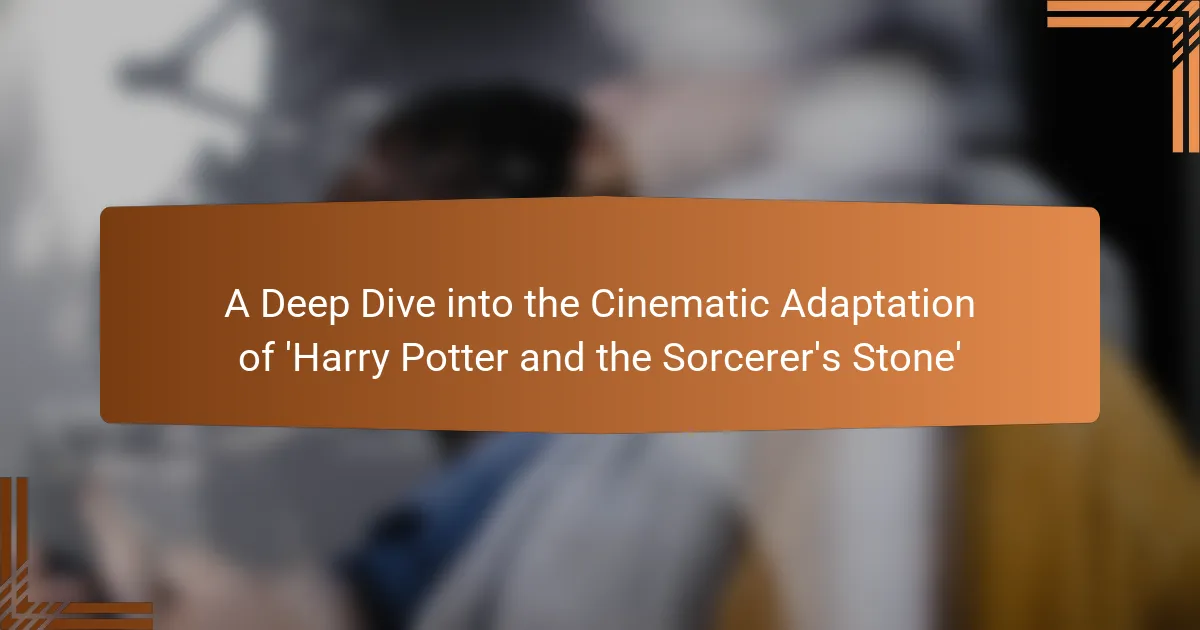The article provides a detailed examination of the film adaptation of ‘Harry Potter and the Sorcerer’s Stone,’ released in 2001 and directed by Chris Columbus. It explores the film’s key elements, including the screenplay, direction, cinematography, casting, production design, music score, and editing, which collectively contribute to its cinematic experience. The article highlights the film’s critical acclaim, positive audience reception, and significant box office success, grossing over $974 million worldwide. It also discusses the film’s impact on the Harry Potter franchise and its role in popularizing the series through its faithful adaptation of J.K. Rowling’s original novel.

What is the Cinematic Adaptation of ‘Harry Potter and the Sorcerer’s Stone’?
The cinematic adaptation of ‘Harry Potter and the Sorcerer’s Stone’ is a film released in 2001. Directed by Chris Columbus, it is based on J.K. Rowling’s novel of the same name. The film introduces audiences to Harry Potter, a young wizard. It follows his journey as he discovers his magical heritage. Key characters include Hermione Granger and Ron Weasley, who become Harry’s friends. The movie showcases pivotal scenes from the book, such as Harry’s arrival at Hogwarts. It received critical acclaim and was a box office success. The film’s visual effects and set designs brought the magical world to life.
How does this adaptation differ from the original book?
The adaptation of ‘Harry Potter and the Sorcerer’s Stone’ differs from the original book in several key ways. The film omits certain subplots, such as the backstory of the character Peeves, the Poltergeist. Additionally, character development is less detailed in the film. For example, the book provides deeper insights into Harry’s feelings about his parents. The film also alters some character interactions, particularly between Ron and Hermione, to streamline the narrative. Certain scenes are condensed for pacing, such as the Quidditch matches. The portrayal of Hogwarts is visually enhanced in the film, offering a different interpretation of the magical setting. Finally, the ending is more action-oriented in the film compared to the book’s detailed resolution. These differences illustrate the challenges of adapting a comprehensive narrative into a limited runtime format.
What are the major plot changes made in the film?
The major plot changes made in the film adaptation of ‘Harry Potter and the Sorcerer’s Stone’ include the omission of certain characters and scenes. For example, the character of Peeves the Poltergeist is not included in the film. Additionally, the backstory of the character Voldemort is simplified. The film also condenses the timeline of events, such as the Quidditch matches and the final confrontation with Professor Quirrell. Some subplots, like the detailed exploration of house-elf culture, are left out. The ending is altered to provide a more conclusive resolution. These changes were made to streamline the narrative for cinematic pacing and clarity.
How do character portrayals differ between the book and the movie?
Character portrayals in ‘Harry Potter and the Sorcerer’s Stone’ differ significantly between the book and the movie. In the book, characters like Hermione Granger exhibit a more complex personality and backstory. For instance, her character is shown to be highly studious and often anxious about her performance. The movie simplifies her character, focusing more on her bravery and friendship.
Additionally, Ron Weasley’s character in the book has more moments of insecurity and family struggles. The film presents him as more confident and humorous, minimizing his personal challenges.
Harry Potter’s internal thoughts and emotions are deeply explored in the book, providing insight into his feelings of isolation. The movie, however, relies on visual storytelling, which limits the depth of his internal struggles.
Overall, while the movie captures the essence of the characters, it condenses their development and complexities for a more streamlined narrative.
Why is this adaptation significant in film history?
The adaptation of ‘Harry Potter and the Sorcerer’s Stone’ is significant in film history due to its groundbreaking success in bringing a beloved literary series to the screen. This film, released in 2001, marked a pivotal moment in the fantasy genre within cinema. It grossed over $974 million worldwide, making it one of the highest-grossing films of all time. The adaptation set a new standard for fidelity to source material, balancing narrative integrity with cinematic storytelling. It also pioneered advancements in visual effects, particularly in depicting magical elements, which influenced future fantasy films. Additionally, the film’s casting of young actors like Daniel Radcliffe, Emma Watson, and Rupert Grint became iconic, establishing a new generation of stars. The success of this adaptation led to a franchise that included seven sequels, profoundly impacting the film industry and popular culture.
What impact did it have on the fantasy genre in cinema?
The cinematic adaptation of ‘Harry Potter and the Sorcerer’s Stone’ significantly impacted the fantasy genre in cinema. It revitalized interest in fantasy films, leading to a surge in adaptations of similar literary works. The film’s success demonstrated the commercial viability of the genre, grossing over $974 million worldwide. This financial success encouraged studios to invest in high-quality fantasy productions. The film also popularized the use of advanced visual effects, setting a new standard for the portrayal of magical worlds. Additionally, it established a dedicated fan base that contributed to the growth of the genre in subsequent years. Overall, ‘Harry Potter and the Sorcerer’s Stone’ played a crucial role in shaping modern fantasy cinema.
How did it influence the production of subsequent Harry Potter films?
The production of ‘Harry Potter and the Sorcerer’s Stone’ set a precedent for subsequent films in the series. It established a successful formula for blending visual effects with storytelling. This approach influenced the pacing and tone of later films. The casting choices created a recognizable ensemble, impacting character development in subsequent installments. The film’s box office success demonstrated the franchise’s marketability, leading to increased budgets for future productions. The collaborative relationship between directors and producers was solidified, ensuring consistent vision across the series. The adaptation process also informed how future screenplays would balance fidelity to the source material with cinematic storytelling. Overall, the first film’s success laid the groundwork for the entire franchise’s production strategy.

What are the key elements of the film’s production?
The key elements of the film’s production include the screenplay, direction, cinematography, and casting. The screenplay adapts J.K. Rowling’s book into a visual narrative. Direction by Chris Columbus shapes the film’s overall vision and tone. Cinematography captures the magical world through lighting and camera work. Casting involves selecting actors who bring iconic characters to life. Production design creates the film’s sets and environments. Music score enhances emotional engagement and storytelling. Editing ensures the film’s pacing and coherence. These elements work together to create a cohesive cinematic experience.
Who were the main creative forces behind the adaptation?
The main creative forces behind the adaptation of ‘Harry Potter and the Sorcerer’s Stone’ were director Chris Columbus and screenwriter Steve Kloves. Chris Columbus directed the film, bringing a visual style and tone that matched the source material. Steve Kloves wrote the screenplay, effectively translating J.K. Rowling’s novel into a cinematic format. Their collaboration was crucial in maintaining the essence of the beloved book. The film was produced by David Heyman, who played a significant role in the adaptation process. Together, this team shaped the film’s narrative and character development. Their contributions ensured the film’s success and resonance with audiences.
What role did the director play in shaping the film’s vision?
The director played a crucial role in shaping the film’s vision. Chris Columbus, the director of ‘Harry Potter and the Sorcerer’s Stone,’ established the film’s tone and style. He focused on creating a faithful adaptation of J.K. Rowling’s book. Columbus emphasized the importance of capturing the magical atmosphere of Hogwarts. His decisions influenced the casting, set design, and overall storytelling. The director’s vision ensured that key themes were effectively portrayed. For instance, he highlighted friendship and bravery throughout the film. Columbus’s direction contributed significantly to the film’s success and reception.
How did the screenwriter approach the adaptation process?
The screenwriter approached the adaptation process by closely analyzing the source material. They focused on capturing the essence of the characters and key plot points. The screenwriter prioritized maintaining the story’s magical elements. They also made necessary changes to fit the cinematic format. This included condensing certain scenes for pacing. The screenwriter collaborated with the director to ensure a cohesive vision. They aimed to appeal to both fans of the book and new audiences. Ultimately, the adaptation balanced fidelity to the original with cinematic storytelling.
What were the challenges faced during production?
The challenges faced during the production of ‘Harry Potter and the Sorcerer’s Stone’ included complex special effects and casting difficulties. The film required groundbreaking visual effects to bring magical elements to life. Many scenes involved intricate CGI that needed extensive planning and execution. Additionally, finding the right actors to portray beloved characters was a significant challenge. The casting process involved auditions for thousands of children. Budget constraints also posed difficulties in securing high-quality sets and locations. The production faced tight deadlines to meet release schedules. Finally, adapting the beloved book into a screenplay while maintaining its essence was a creative challenge. These factors collectively impacted the film’s production timeline and overall execution.
How did budget constraints affect the film’s quality?
Budget constraints negatively impacted the film’s quality by limiting resources for special effects and set design. The film had a reported budget of approximately $125 million. This amount, while substantial, restricted the ability to create more elaborate scenes and effects. For instance, the Quidditch matches and magical creatures had to be produced with careful budget management. The result was a reliance on practical effects over CGI in some instances. Additionally, budget limits affected the casting process, which may have led to less experienced actors in supporting roles. Overall, these constraints contributed to a less polished final product compared to other high-budget fantasy films.
What difficulties arose in casting the lead roles?
Casting the lead roles in ‘Harry Potter and the Sorcerer’s Stone’ faced significant difficulties. One major challenge was finding young actors who could embody the characters’ personalities and complexities. The casting team needed to ensure that the chosen actors could handle the intense scrutiny of public attention. Additionally, there was pressure to select actors who could appeal to both children and [censured] audiences. The audition process was extensive, with thousands of hopefuls vying for the roles. Ultimately, Daniel Radcliffe, Emma Watson, and Rupert Grint were chosen after rigorous auditions. Their performances needed to resonate with both fans of the book and new viewers, adding to the casting pressure.

How was the film received by audiences and critics?
The film ‘Harry Potter and the Sorcerer’s Stone’ received positive reviews from both audiences and critics. It holds an 81% approval rating on Rotten Tomatoes. Critics praised its visual effects and faithful adaptation of the source material. Audiences appreciated the performances, particularly by the young cast. The film grossed over $974 million worldwide, indicating strong viewer interest. It also received several award nominations, including Academy Award nominations for Best Original Score and Best Visual Effects. Overall, the reception highlighted its impact on the franchise and its role in popularizing the Harry Potter series.
What were the box office results for the film?
The box office results for ‘Harry Potter and the Sorcerer’s Stone’ were highly successful. The film grossed over $974 million worldwide. It became the highest-grossing film of 2001. This financial success set the stage for subsequent films in the franchise. The film’s performance was bolstered by its popularity with audiences and positive critical reception. It was also the first film in a series that would become a cultural phenomenon. Its box office achievements reflect the strong fan base of the original book series. The film’s success contributed significantly to the growth of the fantasy film genre.
How did the film perform compared to expectations?
The film ‘Harry Potter and the Sorcerer’s Stone’ exceeded expectations significantly. It grossed over $974 million worldwide against a production budget of $125 million. The film was anticipated to perform well due to the popularity of the book series. However, its box office success surpassed initial projections. It became the highest-grossing film of 2001. Critical reception was also positive, with a 81% approval rating on Rotten Tomatoes. Audience demand was high, leading to record-breaking opening weekend sales. Overall, the film’s performance solidified its status as a cultural phenomenon.
What critical reception did the film receive upon release?
The film ‘Harry Potter and the Sorcerer’s Stone’ received generally positive critical reception upon release. Critics praised its visual effects and faithfulness to the source material. The film holds a 81% approval rating on Rotten Tomatoes. Many reviews highlighted the strong performances of the cast, particularly that of the young actors. The direction by Chris Columbus was also well-received for capturing the magical essence of J.K. Rowling’s world. Some critics noted pacing issues and a lack of depth in character development. Overall, the film was considered a successful adaptation that appealed to both fans and newcomers.
What lasting effects has the film had on popular culture?
The film ‘Harry Potter and the Sorcerer’s Stone’ has significantly influenced popular culture. It popularized the fantasy genre in mainstream cinema. The film’s success led to a surge in adaptations of young [censured] literature. Merchandise related to the film, such as toys and clothing, became widely popular. The film also inspired theme parks and immersive experiences worldwide. Iconic phrases and imagery from the film entered everyday language and references. The film’s impact can be seen in numerous parodies and tributes in various media. It played a crucial role in the resurgence of interest in reading among children and young adults.
How has it influenced the perception of the Harry Potter franchise?
The cinematic adaptation of ‘Harry Potter and the Sorcerer’s Stone’ significantly influenced the perception of the Harry Potter franchise. It established the franchise as a cultural phenomenon, attracting a global audience. The film’s success led to increased visibility for the books, enhancing their popularity. It introduced the characters and magical world to a wider demographic, including those who had not read the books. The visual representation of the story set a standard for future adaptations. Box office success, grossing over $974 million worldwide, solidified its status. The film also sparked discussions about themes such as friendship and bravery, deepening audience engagement. Overall, the adaptation redefined the franchise’s legacy in popular culture.
What are some notable references to the film in other media?
The film ‘Harry Potter and the Sorcerer’s Stone’ has been referenced in various media. For instance, the television series ‘The Big Bang Theory’ includes multiple allusions to the film. Characters frequently discuss the Harry Potter universe. Additionally, the video game series ‘LEGO Harry Potter’ directly incorporates elements from the film. The film is also parodied in shows like ‘Family Guy’ and ‘The Simpsons’. References can be found in books, such as ‘The Harry Potter Lexicon’, which expands on the film’s lore. These references highlight the film’s cultural impact and its integration into popular media.
What can viewers learn from the adaptation process of ‘Harry Potter and the Sorcerer’s Stone’?
Viewers can learn about the complexities of transforming a literary work into a film. The adaptation process involves selecting key plot points from the book. Important characters and themes must be preserved while condensing the narrative. Visual storytelling techniques enhance the emotional impact of the story. The filmmakers’ creative choices shape audience perception of the characters. Changes made for pacing and runtime can alter the original message. Viewers can appreciate the balance between fidelity to the source material and cinematic creativity. The collaboration between screenwriters, directors, and producers is crucial for a successful adaptation.
The main entity of the article is the cinematic adaptation of ‘Harry Potter and the Sorcerer’s Stone.’ This article provides a comprehensive analysis of the film, discussing its release, key characters, and differences from J.K. Rowling’s original book. It explores major plot changes, character portrayals, and the film’s significance in film history, particularly its impact on the fantasy genre and subsequent Harry Potter films. Additionally, it examines production challenges, critical reception, box office performance, and the lasting cultural effects of the film, offering insights into the adaptation process and its implications for future cinematic works.
